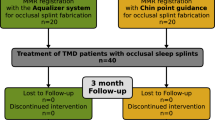Summary
After being extensively used in various forms, indications of occlusal splints are reduced, today, essentially to three types: the Anterior Bite Splint (ABS), the Muscle Reconditioning Splint (MRS) and the AntePositioning Splint (APS). Through these different forms, the authors describe the current knowledge on the temporomandibular disorder treatment by occlusal splint therapy in answering the questions: why, how and when an occlusal splint should be used?
Similar content being viewed by others
References
Al-Ani Z, Gray RJ, Davies SJ, Sloan P, Glenny AM. Stabilization splint therapy for the treatment of temporomandibular myofascial pain: a systematic review. J Dent Educ 2005;69:1242–50
Boero RP. The physiology of splint therapy: a literature review. Angle Orthod 1989;59:165–80
Capp NJ. Occlusion and splint therapy. Br Dent J 1999;186:217–22
Clark GT. A clinical evaluation of orthopedic interocclusal appliance therapy: design, theory, and overall effectiveness. J Am Dent Ass 1984;108:359–64
De Boever J, Nilner M, Orthlieb J-D, Steenks MH. Recommendations by the EACD for examination, diagnosis and management of patients with temporomandibular disorders and orofacial pain by the general practitioner. J Orofac Pain 2008;22:268–78
Dos Santos JJ, De Rijk WG. Vectorial analysis of the instantaneous equilibrium of forces between incisal and condylar guidances. Cranio 1992;10:305–12
DuPont JS Jr, Brown CE. Occlusal splints from the beginning to the present. Cranio 2006;24:141–5
Dylina TJ. A common-sense approach to splint therapy. J Prosth Dent 2001;86:539–45
Ekberg E, Vallon D, Nilner M. The efficacy of appliance therapy in patients with temporomandibular disorders of mainly myogenous origin. A ramdomized, controlled, short-term trial. J Orofac Pain 2003;17:133–9
Forssell H, Kalso E. Application of principles of evidence-based medicine to occlusal treatment for temporomandibular disorders: are there lessons to be learned? J Orofac Pain 2004;18:9–32
Gelb ML, Gelb H. Gelb appliance: mandibular orthopedic repositioning therapy. Cranio Clin Int 1991;1:81–98
Gray RJ, Davies SJ. Occlusal splints and tempromandibular disorders: why, when, how? Dent Update 2001;28:194–9
Greene CS, Laskin DM. Splint therapy for the myofascial pain-dysfunction syndrome: a comparative study. J Am Dent Assoc 1972;84:624–8
Greene CS. The etiology of Temporomandibular disorders: implication for treatment. J Orofac Pain 2001;15:93–105
Hatcher DC, Faulkner MG, Hay A. Temporomandibular joint spatial relationships: osseous and soft tissues. J Prosthet Dent 1986;56:344–53
Holmgren K, Sheikholestam A, Riise C. Effect of a full-arch maxillary occlusal splint on parafunctional activity during sleep in patients with nocturnal bruxism and signs and symptoms of craniomandibular disorders. J Prosthet Dent 1993;69:293–7
Ingerslev H. Functional disturbances of the masticatory system in school children. ASDC J Dent Child 1983;50:445–50
Kai S, Kai H, Tabata O, Shiratsuchi Y, Ohishi M. Long-term outcomes of nonsurgical treatment in nonreducing anteriorly displaced disk of the temporomandibular joint. Oral Surg Oral Med Oral Pathol Oral Radiol Endod 1998;85:258–67
Katsoulis J, Richter M. Efficacy of specific physiotherapy for temporomandibular joint dysfunction of muscular origin. Rev Stomatol Chir Maxillofac 2008;109:9–14
Littner D, Perlm an-Emodi A, Vinocuor E. Efficacy of treatment with hard and soft occlusal appliance in TMD. Refuat Hapeh Vehashinayim 2004;21:52–8
Lobbezzo F, Brouwers JE, Cune MS, Naeije M. Dental implants in patients with bruxing habits. J Oral Rehabil 2006;33:152–9
Macedo CR, Silva AB, Machado MA, Saconato H, Prado G. Occlusal splints for treating sleep bruxism (tooth grinding). Cochrane Database Syst Rev 2007;17:CD005514
McNeill C. History and evolution of TMD concepts. Oral Surg Oral Med Oral Pathol Oral Radiol Endod 1997;83:51–60
Nagels G, Okkerse W, Braem M, et al. Decreased amount of slow wave sleep in nocturnal bruxism is not improved by dental splint therapy. Acta Neurol Belg 2001;101:152–9
Nassif NJ, Al-Ghamdi KS. Managing bruxism and temporomandibular disorders using a centric relation occlusal device. Compend Contin Educ Dent 1999;20:1071–86
Okesson JP. The effects of hard and soft occlusal splint on nocturnal bruxism. J Am Dent Assoc 1987;114:788–91
Orthlieb J-D, Chossegros C, Cheynet F, et al. Cadre thérapeutique des Dysfonctionnements de l'Appareil Manducateur (DAM). L'Information Dentaire 2004;39:2626–32
Scapino RP. The posterior attachment: its structure, function, and appearance in TMJ imaging studies. Part 1. J Craniomandib Disord 1991;5:83–95
Tomonoga A, Ikeda M, Kato H, Ohata N. Inluence of sleep bruxism on dislodgement of dental restaurations. Nippon Hotetsu Shika Gakkai Zasshi 2005;49:221–30
Turp JC, Komine F, Hugger A. Efficacy of stabilization splints for the management of patients with masticatory muscle pain: a qualitative systematic rewiew. Clin Oral Investig 2004;8:179–95
Unger F. The management of temporomandibular joint disorders. The role of occlusal splints. Rev Stomatol Chir Maxillofac 2001;102:47–54
Widmalm SE. Use and abuse of bite splints. Compend Contin Educ Dent 1999;20:249–60
Wright EF. Using soft splints in your dental practice. Gen Dent 1999;47:506–10
Yip KH, Chow TW, Chu FC. Rehabilitating a patient with bruxism-associated tooth tissue loss: a literature review and case report. Gen Dent 2003;51:70–4
Author information
Authors and Affiliations
Corresponding author
Rights and permissions
About this article
Cite this article
Ré, JP., Perez, C., Darmouni, L. et al. The occlusal splint therapy. J. Stomat. Occ. Med. 2, 82–86 (2009). https://doi.org/10.1007/s12548-009-0015-y
Received:
Accepted:
Published:
Issue Date:
DOI: https://doi.org/10.1007/s12548-009-0015-y




